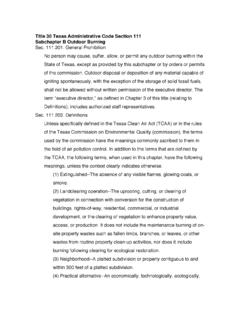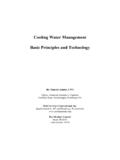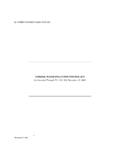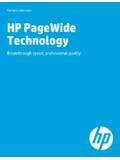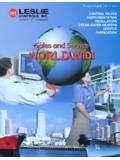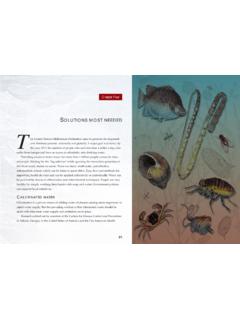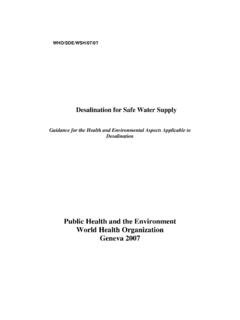Transcription of WATER CODE TITLE 2. WATER ADMINISTRATION …
1 WATER CODETITLE 2. WATER ADMINISTRATIONSUBTITLE D. WATER quality CONTROLCHAPTER 26. WATER quality CONTROLSUBCHAPTER A. ADMINISTRATIVE PROVISIONSSec. DEFINITIONS. As used in this chapter:(1) "Board" means the Texas WATER Development Board.(2) "Commission" means the Texas Natural Resource Conservation Commission.(3) "Executive administrator" means the executive administrator of the Texas WATER Development Board.(4) "Executive director" means the executive director of the Texas Natural Resource Conservation Commission.(5) " WATER " or " WATER in the state" means groundwater, percolating or otherwise, lakes, bays, ponds, impounding reservoirs, springs, rivers, streams, creeks, estuaries, wetlands, marshes, inlets, canals, the Gulf of Mexico, inside the territorial limits of the state, and all other bodies of surface WATER , natural or artificial, inland or coastal, fresh or salt, navigable or nonnavigable, and includ-ing the beds and banks of all watercourses and bodies of surface WATER , that are wholly or par-tially inside or bordering the state or inside the jurisdiction of the state.
2 (6) "Waste" means sewage, indus-trial waste, municipal waste, recreational waste, agricultural waste, or other waste, as defined in this section.(7) "Sewage" means waterborne human waste and waste from domestic activities, such as washing, bathing, and food preparation.(8) "Municipal waste" means WATER -borne liquid, gaseous, or solid substances that result from any discharge from a publicly owned sewer system, treatment facility, or disposal system.(9) "Recreational waste" means wa-terborne liquid, gaseous, or solid substances that emanate from any public or private park, beach, or recreational area.(10) "Agricultural waste" means wa-terborne liquid, gaseous, or solid substances that arise from the agricultural industry and agricultural activities, including without limi-tation agricultural animal feeding pens and lots, structures for housing and feeding agri-cultural animals, and processing facilities for agricultural products.
3 The term:(A) includes:(i) tail WATER or runoff WATER from irrigation associated with an animal feeding operation or concentrated animal feeding operation that is located in a major sole source impairment zone, as defined by Section ; or(ii) rainwater runoff from the confinement area of an animal feeding operation or concentrated animal feeding opera-tion that is located in a major sole source im-pairment zone, as defined by Section ; and(B) does not include tail wa-ter or runoff WATER from irrigation or rainwater runoff from other cultivated or uncultivated range land, pasture land, and farmland or rain- WATER runoff from an area of land located in a major sole source impairment zone, as defined by Section , that is not owned or controlled by an operator of an animal feeding operation or concentrated animal feeding operation on which agricultural waste is applied.
4 (11) "Industrial waste" means wa-terborne liquid, gaseous, or solid substances that result from any process of industry, manu-facturing, trade, or business.(12) "Other waste" means garbage, refuse, decayed wood, sawdust, shavings, bark, sand, lime, cinders, ashes, offal, oil, tar, dyestuffs, acids, chemicals, salt WATER , or any other substance, other than sewage, industrial waste, municipal waste, recreational waste, or agricultural waste.(13) "Pollutant" means dredged spoil, solid waste, incinerator residue, sewage, garbage, sewage sludge, filter backwash, muni-tions, chemical wastes, biological materials, radioactive materials, heat, wrecked or dis-carded equipment, rock, sand, cellar dirt, and industrial, municipal, and agricultural waste discharged into any WATER in the state.
5 The term:(A) includes:(i) tail WATER or runoff WATER from irrigation associated with an animal feeding operation or concentrated animal feeding operation that is located in a major sole source impairment zone as defined by Section ; or(ii) rainwater runoff from the confinement area of an animal feeding operation or concentrated animal feeding opera-tion that is located in a major sole source im-pairment zone, as defined by Section ; and(B) does not include tail wa-ter or runoff WATER from irrigation or rainwater runoff from other cultivated or uncultivated rangeland, pastureland, and farmland or rain- WATER runoff from an area of land located in a major sole source impairment zone, as defined by Section , that is not owned or controlled by an operator of an animal feeding operation or concentrated animal feeding operation on which agricultural waste is applied.
6 (14) "Pollution" means the altera-tion of the physical, thermal, chemical, or bio-logical quality of, or the contamination of, any WATER in the state that renders the WATER harm-ful, detrimental, or injurious to humans, animal life, vegetation, or property or to public health, safety, or welfare, or impairs the use-fulness or the public enjoyment of the WATER for any lawful or reasonable purpose.(15) "Sewer system" means pipe-lines, conduits, storm sewers, canals, pumping stations, force mains, and all other construc-tions, devices, and appurtenant appliances used to transport waste.(16) "Treatment facility" means any plant, disposal field, lagoon, incinerator, area devoted to sanitary landfills, or other facility installed for the purpose of treating, neutral-izing, or stabilizing waste.
7 (17) "Disposal system" means any system for disposing of waste, including sewer systems and treatment facilities.(18) "Local government" means an incorporated city, a county, a river authority, or a WATER district or authority acting under Article III, Section 52, or Article XVI, Section 59 of the Texas Constitution.(19) "Permit" means an order issued by the commission in accordance with the proce-dures prescribed in this chapter establishing the treatment which shall be given to wastes be-ing discharged into or adjacent to any WATER in the state to preserve and enhance the quality of the WATER and specifying the conditions under which the discharge may be made.(20) "To discharge" includes to de-posit, conduct, drain, emit, throw, run, allow to seep, or otherwise release or dispose of, or to allow, permit, or suffer any of these acts or omissions.
8 (21) "Point source" means any dis-cernible, confined and discrete conveyance, in-cluding but not limited to any pipe, ditch, channel, tunnel, conduit, well, discrete fis-sure, container, rolling stock, concentrated animal feeding operation, or vessel or other floating craft, from which pollutants or wastes are or may be discharged into or adjacent to any WATER in the state.(22) "Identified state supplement to an NPDES permit" means any part of a permit on which the commission has entered a written designation to indicate that the commission has adopted that part solely in order to carry out the commission's duties under state statutes and not in pursuance of ADMINISTRATION undertaken to carry out a permit program under approval by the Administrator of the United States Environmental Protection Agency.
9 (23) "NPDES" means the National Pollutant Discharge Elimination System under which the Administrator of the United States En-vironmental Protection Agency can delegate per-mitting authority to the State of Texas in ac-cordance with Section 402(b) of the Federal Wa-ter Pollution control Act.(24) "Treatment works" means any devices and systems used in the storage, treat-ment, recycling, and reclamation of waste to im-plement this chapter or necessary to recycle or reuse WATER at the most economical cost over the estimated life of the works, including:(A) intercepting sewers, out-fall sewers, pumping, power, and other equipment and their appurtenances;(B) extensions, improvements, remodeling, additions, and alterations of the items in Paragraph (A) of this subdivision;(C) elements essential to pro-vide a reliable recycled supply such as standby treatment units and clear-well facilities.
10 (D) any works, including sites and acquisition of the land that will be a part of or used in connection with the treatment process or is used for ultimate disposal of residues resulting from such treatment;(E) any plant, disposal field, lagoon, canal, incinerator, area devoted to sanitary landfills, or other facilities in-stalled for the purpose of treating, neutraliz-ing, or stabilizing waste; and(F) facilities to provide for the collection, control , and disposal of waste heat.(25) "Person" means an individual, association, partnership, corporation, munici-pality, state or federal agency, or an agent or employee thereof.(26) "Affected county" is a county to which Subchapter B, Chapter 232, Local Gov-ernment Code, D. PROHIBITION AGAINST POLLUTION; EN-FORCEMENTSec.
